F.L.
ACCESS: Top Secret
Last edited:
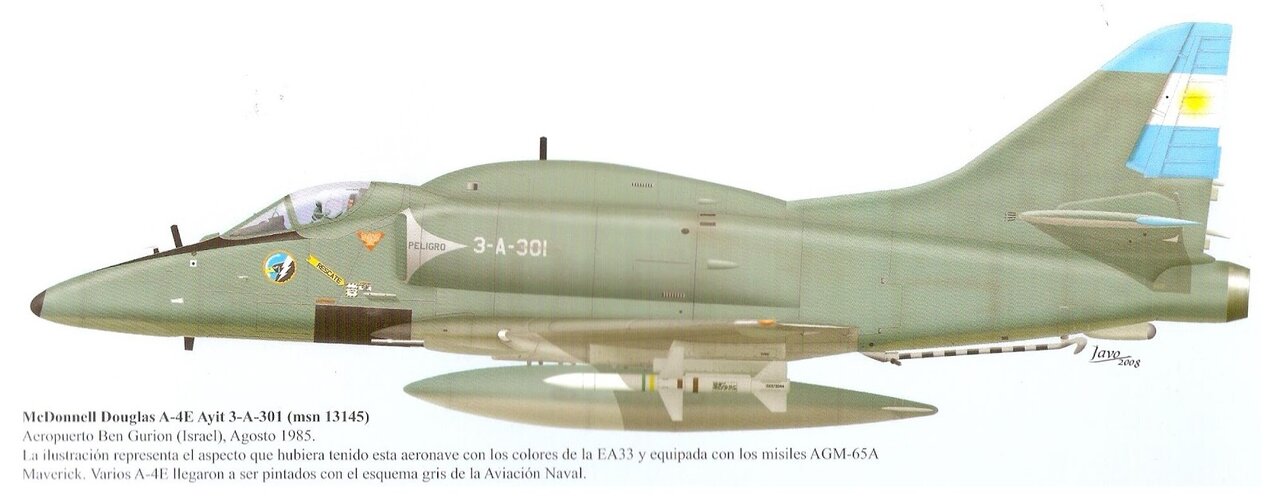
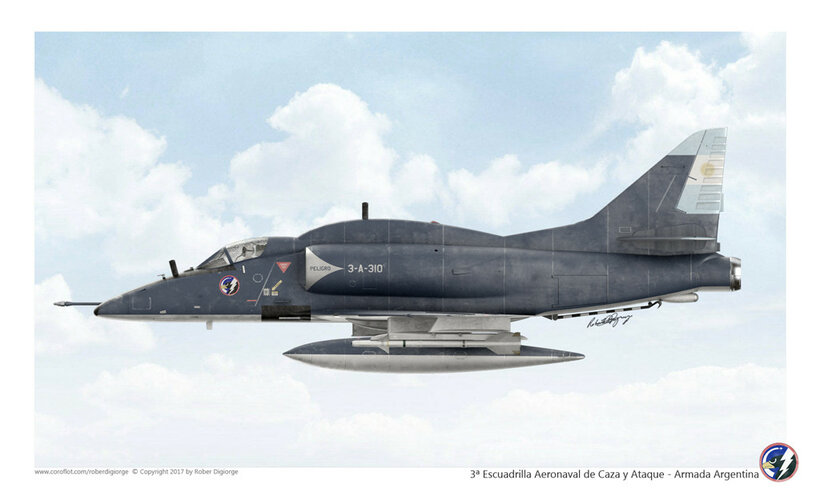
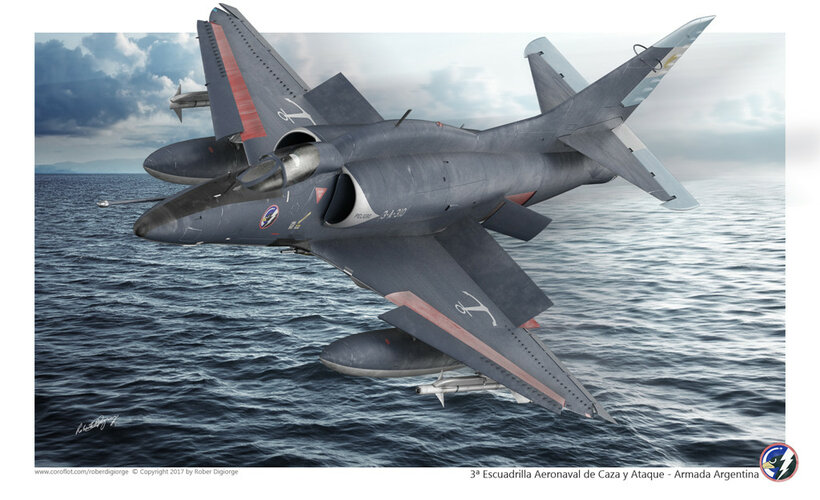
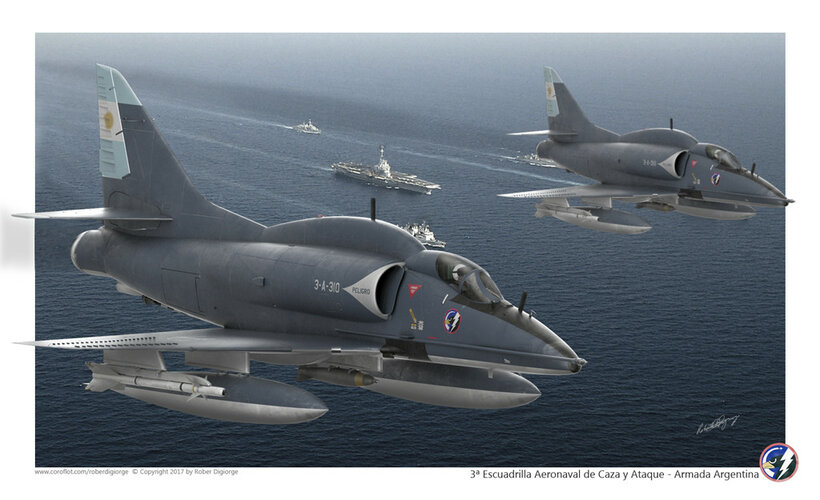


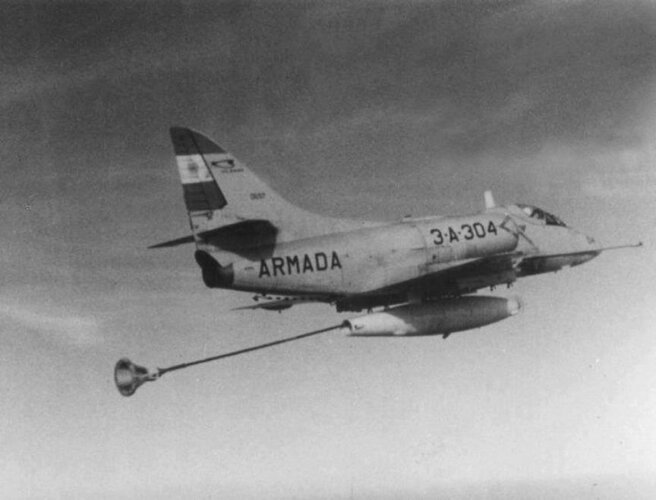
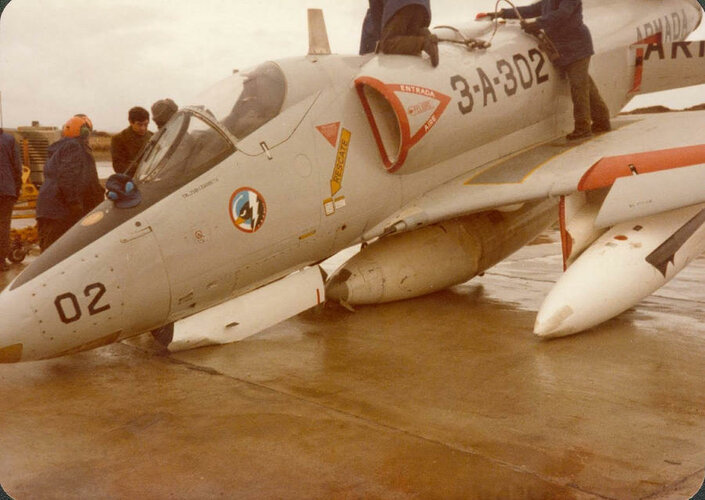
Small amount of fuel.The Argentinians received in-flight refuelling pods with the Skyhawks in the early 1970s.
Between 1986 and 1987, when the A-4Qs were withdrawn from front-line service with the 3ra Escuadrilla Aeronaval de Ataque, they were transferred to the Segunda Escuadrilla Aeronaval de Caza y Ataque to serve on reconnaissance missions and as air-to-air refuellers.
I wonder why they didn't use them for AAR during the conflict ?
View attachment 713659View attachment 713661
One Skyhawk refueling 4 other A-4s can extend their combat radius by ~25%, which is pretty significant and useful. Same ratio applies to just about any buddy tanker scenario.But, as you said - not much fuel, and that range problem from the continent was probably too much for the pods to make a significant difference...
Can still be an extra 8500lbs of fuel, which is 2000lbs more than the entire fuel load of a standard A-4...The Argentinians received in-flight refuelling pods with the Skyhawks in the early 1970s.
Between 1986 and 1987, when the A-4Qs were withdrawn from front-line service with the 3ra Escuadrilla Aeronaval de Ataque, they were transferred to the Segunda Escuadrilla Aeronaval de Caza y Ataque to serve on reconnaissance missions and as air-to-air refuellers.
I wonder why they didn't use them for AAR during the conflict ?
View attachment 713659View attachment 713661
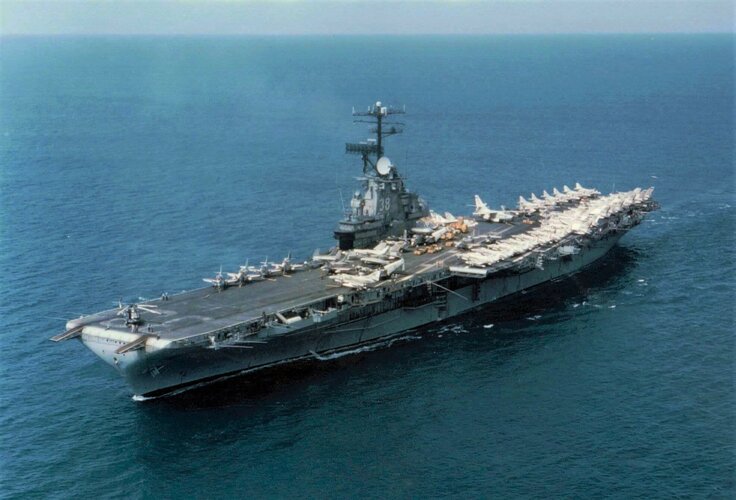
I'd guess F-11s.What if the Argentinians had bought an Essex SCB-125 instead of the Karel Doorman ?
For example, the USS Yorktown (CV-10) retired from service in 1970, or the Shangri-La (CV-38).
What might its Argentine air group have looked like ?
Surely A-4Q Skyhawks & S-2 Trackers, but probably also Crusader or F-11 Tiger ?
This would probably have allowed the Argentinians to launch an attack against the British fleet.
View attachment 714428
HMS Centaur or another medium fleet carrier would be a better choice probably.What if the Argentinians had bought an Essex SCB-125 instead of the Karel Doorman ?
This would probably have allowed the Argentinians to launch an attack against the British fleet.
The USS Oriskany was offered to Argentina around 1976.What if the Argentinians had bought an Essex SCB-125 instead of the Karel Doorman ?
For example, the USS Yorktown (CV-10) retired from service in 1970, or the Shangri-La (CV-38).
What might its Argentine air group have looked like ?
Surely A-4Q Skyhawks & S-2 Trackers, but probably also Crusader or F-11 Tiger ?
This would probably have allowed the Argentinians to launch an attack against the British fleet.
View attachment 714428

That's a great idea !!!Agree 100% (essex class to big for our navy)
I choose this (paying the rapairs -specialy her boilers)
What if the Argentinians had bought an Essex SCB-125 instead of the Karel Doorman ?
For example, the USS Yorktown (CV-10) retired from service in 1970, or the Shangri-La (CV-38).
What might its Argentine air group have looked like ?
Surely A-4Q Skyhawks & S-2 Trackers, but probably also Crusader or F-11 Tiger ?
This would probably have allowed the Argentinians to launch an attack against the British fleet.
H-K:
HMS Centaur or another medium fleet carrier would be a better choice probably.
alejandrogrossi
Agree 100% (essex class to big for our navy)
I now understand why the Argentinians didn't take up the American offer to sell them an Essex instead of the HMS Warrior.25 de Mayo crew: 1,000 ship's company, 300 air group personnel.
Centaur class crew: 1,100 ship's company, 300-350 air group personnel.
Modernized Essex class: 2,600 ship's company, 848 air group personnel (USN levels).
Australia also passed on a US offer of a modernized Essex in 1965 for the same manpower reason - as did Canada when offered two in 1952.I now understand why the Argentinians didn't take up the American offer to sell them an Essex instead of the HMS Warrior.
Buying a Centaur would have been a very good option instead of the 25 de Mayo.
Certanly I choose the Centaur class25 de Mayo crew: 1,000 ship's company, 300 air group personnel.
Centaur class crew: 1,100 ship's company, 300-350 air group personnel.
Modernized Essex class: 2,600 ship's company, 848 air group personnel (USN levels).
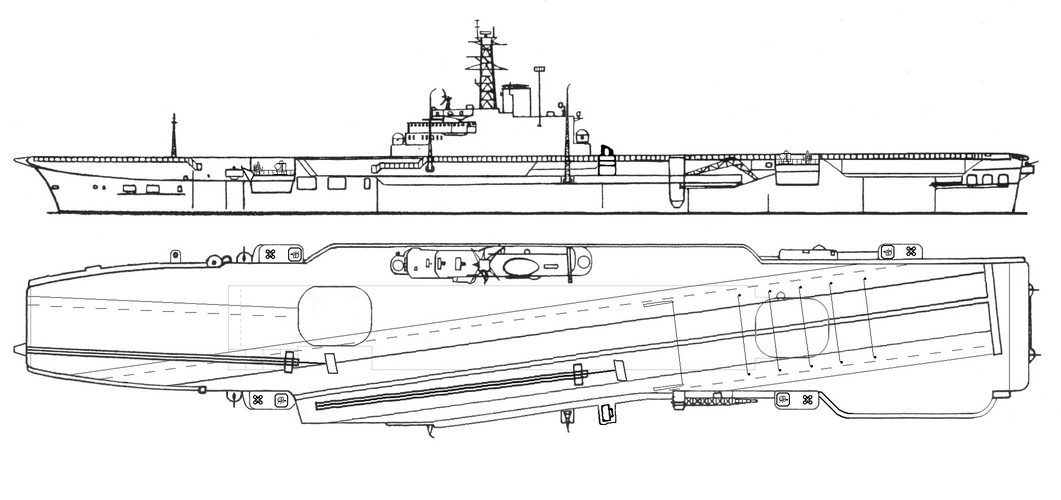
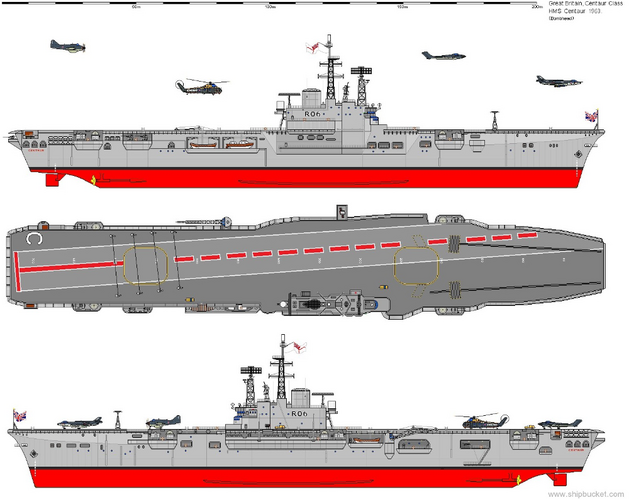
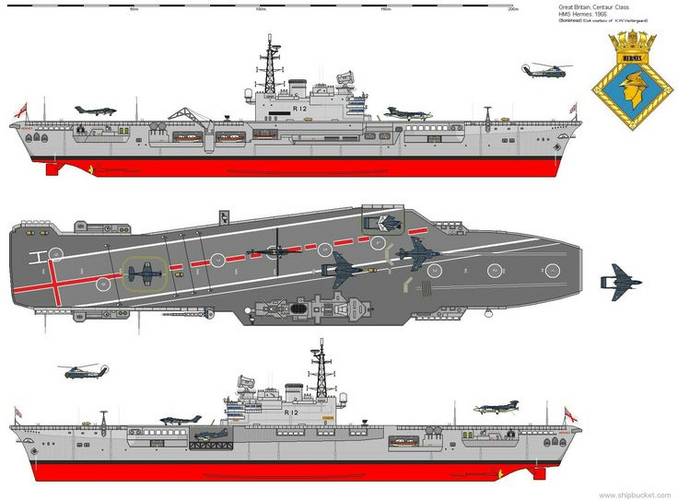

At least 4, maybe more.How many pods did they get total in the 70's ?
uk75An Argentine Centaur with two T42 escorts and a Crusader/Super Etendard or even Buccaneer S2 airgroup would have been a fine sight.
Even better if she never had to go to war and exercised routinely with Clem/Foch or CVA01.

Eight of each ?Her air group F-8/A-4Q (8)
At war time the Naval have: 4 SUE +1 for spares / 8 A-4Q. I dont know how many planes can carry the Vic or the Centaur.Eight of each ?
Eight F-8Q & eight A-4Q ?
It's hard to add an angled deck to the British carriers, the flight deck is their strength deck so any changes get complicated. Yours may be simple enough to be affordable, as it looks like you just need to add some counterweight to the starboard side to make up for it. Or do something fancy like bump the entire island farther from the centerline, accepting the trouble of putting a bend in the trunking.With an angle deck like the Hermes (not the deck edge lif) only the extende angle deck. The I move the foward lift like your and the 2 long cat
This is my idea (sorry for my rough design)
View attachment 714467
Thanks for your replyIt's hard to add an angled deck to the British carriers, the flight deck is their strength deck so any changes get complicated. Yours may be simple enough to be affordable, as it looks like you just need to add some counterweight to the starboard side to make up for it. Or do something fancy like bump the entire island farther from the centerline, accepting the trouble of putting a bend in the trunking.

I ansewer my self YESThanks for your reply
Whw you say this "Or do something fancy like bump the entire island farther from the centerline, accepting the trouble of putting a bend in the trunking"
You mean this?
View attachment 714492

Yes, something like that. Picture a balance scale, with one pan closer to the center than the other, and adjustable in position. This represents the ship. If you add more weight to the pan farther from the center with the angled deck hanging over the side, you either need to add more weight to the close pan to keep everything balanced, or you need to move the close pan farther from the center.Thanks for your reply
Whw you say this "Or do something fancy like bump the entire island farther from the centerline, accepting the trouble of putting a bend in the trunking"
You mean this?
View attachment 714492
The Argentinians then have to contend with the Ark Royal, with its Phantoms and Buccaneers !Argentina takes the Falkland islands in 1976
I know it would be very interesting and ironic too the british have exocet on at least 2 of their ships at this time!! they don't have many missiles. But in real life they deployed them on the ships during operation Journyman in 1977 when the junta for Argentina landed on Thule island.The Argentinians then have to contend with the Ark Royal, with its Phantoms and Buccaneers !
What's more, I don't think they've received the IAI Daggers yet, which means they're missing out on a lot of equipment.
Hi All
So .. My scenario is Argentina takes the Falkland islands in 1976 instead ...
I think it would be the juntas way to distract. I agree the out come would be no different than 1982 especially if Argentinian can't get many A-4's over the island. I think by 1976-77 the HMS Eagle was out of service and Hermes was under going a mild conversion. . Maybe the junta in 1976-77 thought the same as the 1982 junta the British wouldnt fight for the islands!!I'm curious as to why you've chosen 1976 for your Malvinas campaign.
I get that 1976 was the year of Britain's 'sterling crisis' in the midst of hyper-inflation. But was Argentina's economic situation much better? Argentina had, after all, had 22 x finance ministers between 1960 and 1976. Or would this invasion be the Junta's way of distracting public gaze from the Dirty War and its desaparecidos?
Then there is the question of naval superiority. In 1976, Argentina had 1 x WW2-era Colossus class Veinticinco de Mayo and two ex-Brooklyn class cruisers - C-4 General Belgrano and C-5 Nueve de Julio (both built in 1935). By contrast, the Royal Navy still had three aircraft carriers in service in 1976 - as F.L. alluded.
.
The 1976 RN had 2 x Audacious class carrier - HMS Eagle (R05) along with HMS Ark Royal (R09). And also still in service was the Centaur class HMS Hermes (R12) which had been converted into a 'Commando Carrier'. Another Centaur class carrier (and 'Commando Carrier' conversion) - HMS Bulwark (R08) - had been place in Reserve in March of 1976. It would have been a fairly simple matter to return Bulwark to operational condition under 'wartime' conditions.
I guess my question is: Had Argentina been able to occupy the islands in 1976, what would have then saved the ARA and FAA from then taking a pummeling from RN Buccs and Phantoms? And, if not so saved, what would prevent the Centaur class ships from landing Royal Marines in force in San Carlos Water?
